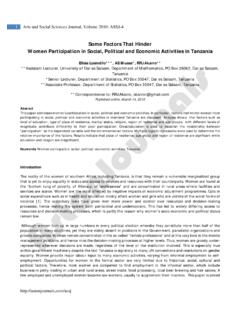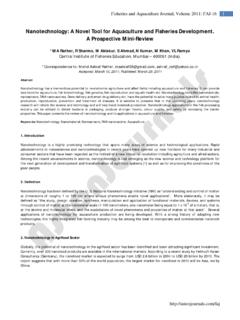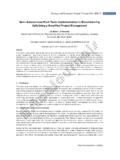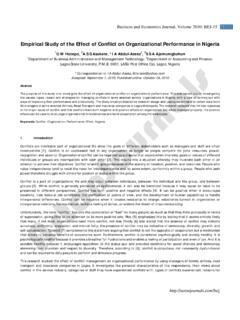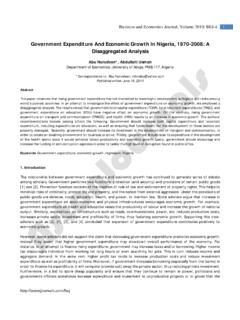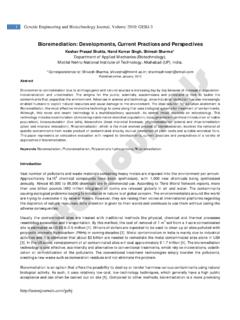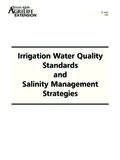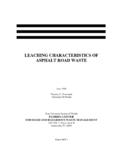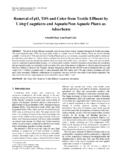Transcription of Total Dissolved Solids Removal in Wastewater …
1 Chemical Sciences Journal, Volume 2010: CSJ-6 1. Total Dissolved Solids Removal in Wastewater Using Roughing Filters *O I Nkwonta, G M Ochieng Department of Civil Engineering, Tshwane University of Technology, Private Bag x680, Pretoria 0001, South Africa *Correspondence to: O I Nkwonta, Published online: May 19, 2010. Abstract Wastewater treatment using local available materials such as gravel and charcoal was investigated. The Removal of TDS from roughing filters was evaluated for roughing filtration treatment system. Achieved results showed that roughing filters could be considered as a major pre- treatment process for Wastewater , since they efficiently separate fine Solids particles over prolonged periods without addition of chemicals. A. pilot plant was designed at delcoal. The Wastewater used was from delcoal.
2 The design and sizing of the pilot plant was guided by wegelin design criteria. Gravel was used as a control medium since it is one of the most commonly used roughing filter media and because it was used in developing these criteria. In order to improve the performance of roughing filters, this process has been modified by applying local available material such as charcoal as an alternative filter media. The pilot plant was monitored for a continuous 90 days from commissioning. The overall function of the filter in removing parameters such as TDS is accepted using charcoal as an alternative filter media. Achieved results in this study showed that roughing filters might be considered as an efficient pretreatment process for mine water. It was also observed that in general performance, charcoal performed better than gravel.
3 This observation could have resulted from the reason that charcoal has a slightly higher specific surface area and porosity respectively to enhance sedimentation and other filtration processes like adsorption, compared to gravel. Keywords: Roughing filters; Sedimentation; Adsorption; Mine water; Gravel; Charcoal. 1. Introduction Water is essential to life on our planet [1]. This fundamental resource is of such importance because no living organism can survive without water, [2]. Therefore, there is a demand for clean, unpolluted water in substantial supply. As a result, a prerequisite of sustainable development, therefore, must be obtained, to ensure uncontaminated streams, rivers, lakes and oceans [3]. Increasingly, human activities threaten the water sources on which we all depend. Water supplies continue to dwindle because of resource depletion and pollution, whilst demand is rising fast because of population growth, industrialisation, mechanisation and urbanisation [4].
4 This situation is particularly acute in the more arid regions of the world where water scarcity, and associated increases in water pollution, limit social and economic development and are linked closely to the prevalence of poverty, hunger and disease [4]. Over 70% of the water used in both rural and urban areas in South Africa is surface water drawn from rivers, streams, lakes, ponds and springs [5]. Water and soil contamination caused by acid mine drainage (AMD) is a significant environmental problem in some parts of the world, particularly in densely populated developing countries where human habitats are usually in close proximity to mine sites [6]. Water draining from coal and base metal mines frequently contains sulfuric acid and heavy metals at high levels, which could contaminate streams and agricultural lands, when the mine water or mine water-affected stream water is used for irrigation purposes.
5 Entry of mine-originated contaminants into agricultural soils and streams may also occur during heavy rainfall events that cause over-bank flooding. Elevated concentrations of heavy metals in the soils and streams, accompanied with acidic pH, are likely to enhance uptake of heavy metals by plants and man, which poses a high health risk to the people who consume the contaminated agricultural products. This scenario thus calls for efficient and effective treatment of water from such sources before use, to avoid instances of water borne and water related diseases such as typhoid fever and cholera. One of the systems derived to treat this water is known as Roughing filters. Roughing filters can be considered as a major pretreatment process for mine water, since they efficiently separate fine solid particles over prolonged periods without addition of chemicals.
6 Roughing filters are simple, efficient and cheap mine water pre- treatment technology compared to the conventional system. This is in terms of technical labour requirement, daily operation, maintenance costs and treatment efficiency and effectiveness. Roughing filters are primarily used to separate fine Solids from the water that are only partly or not retained at all by stilling basin or sedimentation tanks. Roughing filters mainly acts as physical filters and reduce the solid mass. However, the large filter surface area available for sedimentation and relatively small filtration rates also supports adsorption as well as chemical and biological processes. Therefore, besides solid matter separation, roughing filters also partly improve the bacteriological water quality and, to a minor extent, change some other water quality parameters such as colour or amount of Dissolved organic matter [7].
7 Roughing filters are classified as deep-bed filters, whereby proper filter design promotes particle Removal throughout 2 Research Article the depth of the filter bed, maximising the capacity of the filter to store removed Solids . Particle Removal efficiency in roughing filters is dependent on filter design, particulate, and water quality parameters [8]. 2. Methods In this study, horizontal roughing filters were selected as the pretreatment filters. Horizontal roughing filters perform better than other treatment filters, like Vertical roughing filters [8]. Horizontal roughing filters also have advantage of simplicity in design, cleaning, and operation. To conduct this study, a pilot plant was constructed at delcoal in Mpumalanga province of South Africa. To enable a comparative study, two horizontal roughing filters were constructed.
8 The design and sizing of the pilot plant was guided by the wegelin design criteria [9]. This study aimed at verifying these criteria based on gravel as a filter medium and other local available possible filter media, namely charcoal due to, it can serve as an alternative where gravel is not available. The filter medium was placed in different filters that consist of a chamber. The compartment was filled up of medium sizes of 15mm . 5mm decreasing in size in the direction of flow. The filter bed was provided with under drain system, so that it will allow cleaning of the filters after a certain period. A constant filtration rate of 1m/h was used. Standard methods were adopted and analysis of the selected performance monitoring parameters. In this study, TDS was used as performance monitoring parameter. The filter inlet and outlet values of this parameter were monitored with the aim of analysing the Removal efficiency of the roughing filters at the set field operating conditions.
9 Monitoring was done on a daily basis due to development of excessive filter resistance and to prevent algal growth in the filter. Design Concept The design period, projected population growth and per capita water demand all have considerable impact on the size of roughing filters [10]. Since filter efficiency increases with decreasing filter material, it is good to use the smallest possible filter material or even to omit the larger filter materials [9] and to install only one finest filter medium. However, the roughing filtration technology requires coarse filter materials as denoted by its name [9]. The finest filter material should not be more than 4 mm to ease hydraulic filter cleaning. Filter material, which is too coarse however, has smaller filter efficiency and would therefore require a longer filter length to achieve the same reduction [9].
10 Some preliminary design guidelines for horizontal roughing filters were shown in Table 1. Table 1: Shows the recommended guidelines for roughing filter design from researchers. Parameters Younger (1999) Galvis (1998) Wegelin (1996) Tarmar Evans (1999). (2006). Water source Mine water Drinking water Waste water Drinking Drinking water water Filtration rate (m/h). Filter length (m) 66 2 50 5 3. Gravel sizes (mm) 40-25 25-19 60-40 16-2 5-1. Compartment (m) 3 3 3 3 2. In this study, the filter design variables were based on previous research findings for mine water and drinking water treatments. Figure 1 shows the pilot plant scale units used in the research. 3. Results and Discussion In order to monitor the quality of outlet water, parameter such as TDS is being compared between the inlet and outlet water. The Removal of the mentioned parameter in the inlet and outlet are shown in figure 1.
